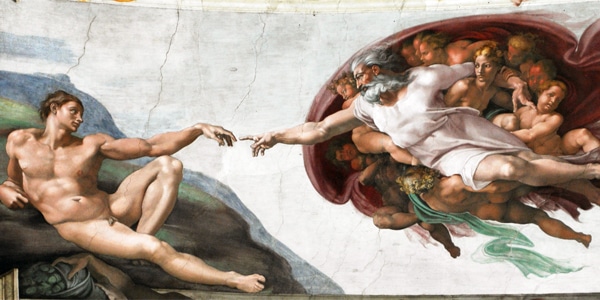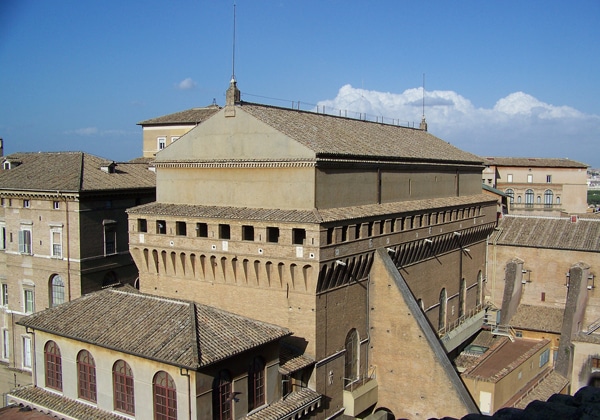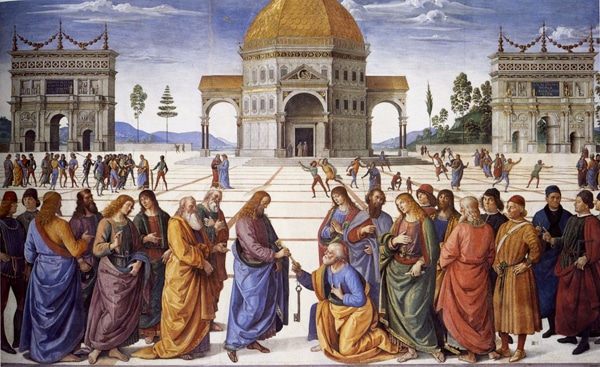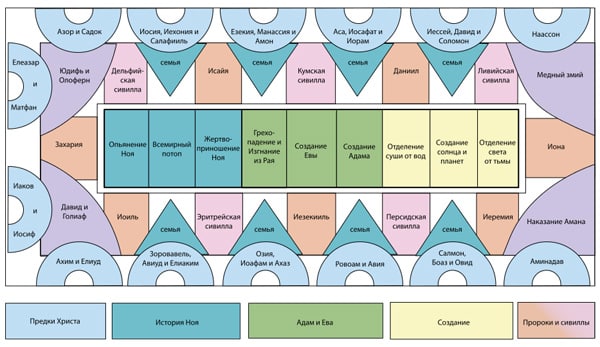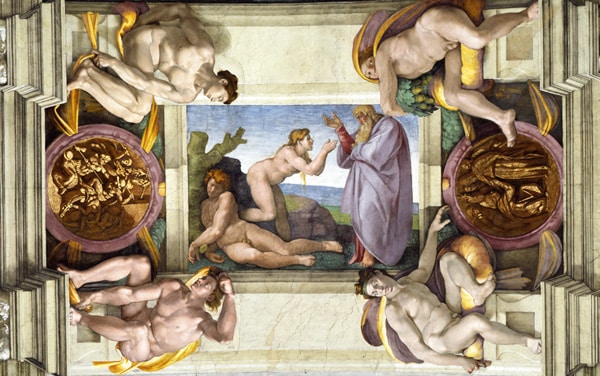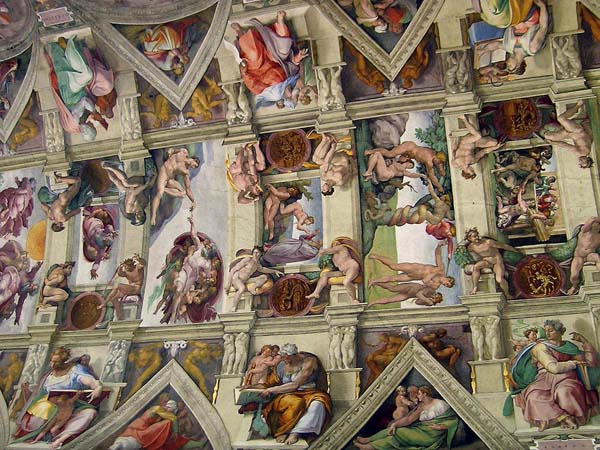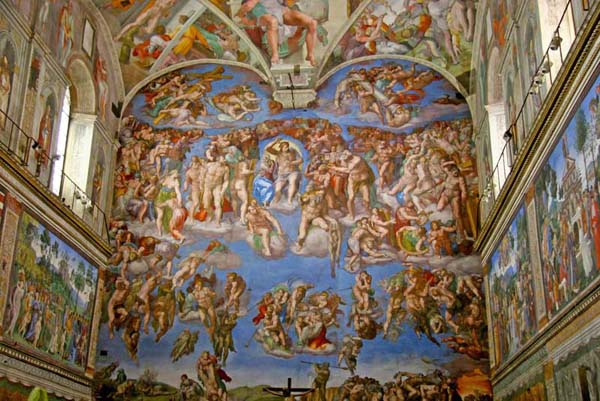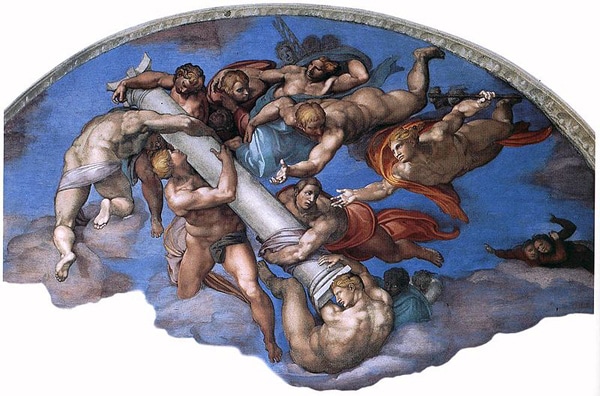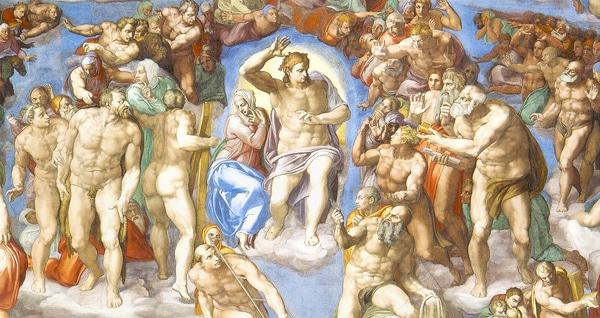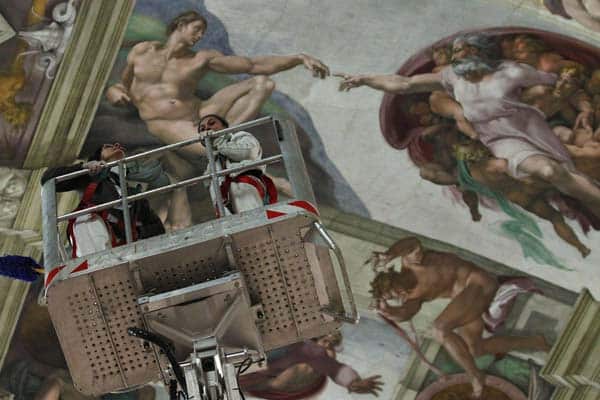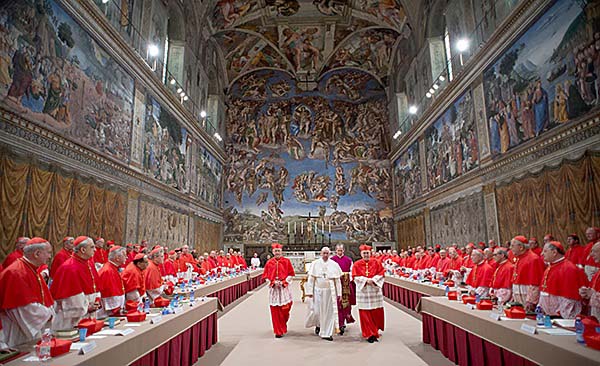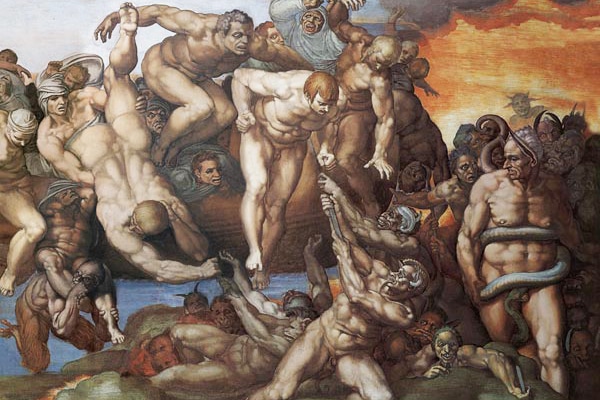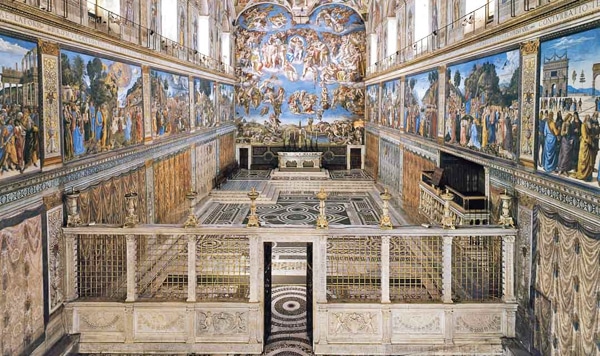The Sistine Chapel (Cappella Sistina) from the outside appears as an unremarkable 15th-century church building within the modern Vatican. However, within walls clad in sand-colored stone lie true Renaissance gems – works by Michelangelo Buonarroti, Sandro Botticelli, Perugino, Pinturicchio, Domenico Ghirlandaio.
Page Contents
What You Need to Know Before Visiting the Sistine Chapel
History of the Creation of the Sistine Chapel
The Sistine Chapel was built in 1475-1481 by order of Pope Sixtus IV (Sisto IV) in honor of the Assumption of Mary into heaven.
The location for the church was chosen not by chance. Previously, this site in Rome housed the Great Chapel (Cappella Maggiore), which hosted the highest conclaves of the Catholic clergy. The grand reconstruction of the outdated chapel was entrusted to architect Baccio Pontelli and engineer Giovannino de’ Dolci.
The head of construction decided to preserve the foundation and part of the lower tier of the old building. During construction, the church gained 3 floors, 2 intended for church needs, and the top one was a gallery for the guard soldiers. The chapel itself also represents an example of fortification architecture: a rectangular building 20.7 m high, 40.9 m long, and 13.4 m wide. The turbulent situation in fragmented Italy during the Middle Ages dictated strong walls and the absence of refinements.
Frescoes
The Sistine Chapel is known worldwide for its frescoes adorned its vault and walls in the 15th-16th centuries. The overall plan for the church’s fresco decoration was developed during construction. The building was divided into three horizontal tiers and was to be decorated from bottom to top. The lower tier had simple decorative paintings, and the second tier was dedicated to events from the Old Testament and scenes from the life of Christ as reflected in the New Testament. The highest tier was to depict pontiffs who had suffered martyrdom.
Florentines
The decoration of the Sistine Chapel was initiated by Perugino, a master of the Umbrian school of painting. He depicted two paintings from the life of Christ and one from the Old Testament. By 1480, the tense political relations between Pope Sixtus IV and the head of the Florentine Signoria, Lorenzo de’ Medici the Magnificent (Lorenzo de Medici), had somewhat warmed.
As a gesture of goodwill, Medici sent masters of the Florentine school: Botticelli, Ghirlandaio, Cosimo Rosselli, and the pontiff graciously allowed them to settle in Rome and begin work in the Sistine Chapel.
Supported by Pinturicchio and Bartolomeo della Gatta, the Florentines painted the walls of the new church. The themes of the 10 frescoes were developed and approved in detail by Sixtus IV himself. Special attention was paid to ensuring that the compositions from the Old and New Testaments harmoniously complemented each other. The impression from the iconographic paintings was enhanced by artist Piermatteo d’Amelia, who depicted the temple’s vault in a starry sky.
The Ceiling of the Sistine Chapel
The successor of Sixtus IV, his nephew Julius II (Ulius II), never forgot what the Sistine Chapel meant for the Catholic Church.
Contribution of Michelangelo Buonarroti
In 1508, the pontiff invited Michelangelo Buonarroti to restore the existing paintings and add new ones. It took the famous master four years (from 1508 to 1512) to decorate the vault.
Interestingly, at that time, Michelangelo was considered an unsurpassed architect, while frescoes were something new to him.
Contemporaries of the sculptor see the handiwork of Buonarroti’s rival, Donato Bramante, in what happened. Bramante had his own candidate for creating the fresco — Raphael Santi (Raffaello Santi).
The ceiling of the Sistine Chapel was a real challenge for Michelangelo.
Besides mastering a new artistic technique, the master had to solve organizational issues. For instance, how to erect scaffolding up to the ceiling without hindering church ceremonies? “Flying scaffolds,” designed by the artist, were mounted on unique pegs to the church walls. Thus, the artist and his assistants were at the necessary height, and the clergy had freedom of movement.
There are various speculations about Buonarroti’s work under the chapel’s vault. Some sources claim that the master worked lying down, with paint and plaster copiously falling onto his face. In reality, Michelangelo worked standing up, having space for maneuvers. However, the strenuous work under the chapel’s ceiling damaged the health of the 33-year-old artist.
To top it all, the damp layers of plaster, on which the painting was conducted, began to be heavily covered with mold. The master and his assistants developed a new formula for “intonaco” — a plaster impregnation compound resistant to the humid Roman air.
Despite all the vicissitudes, the ceiling of the Sistine Chapel was adorned with frescoes combined into a single iconographic cycle. Michelangelo depicted paintings illustrating nine scenes from the Book of Genesis. In the vault miniatures, one can see “The Separation of Light from Darkness,” “The Sacrifice of Noah,” “The Creation of Adam,” “The Fall of Man,” “The Expulsion from Paradise.”
The Sistine Chapel’s ceiling has three distinctly expressed narrative chains: the creation of the World, Adam and Eve, and the burdens of humanity deprived of Paradise.
Examining each painting individually, one can trace the evolution of Buonarroti’s painting style. Due to the great height of the ceiling, the artist forwent small details and intricate curls in favor of more succinct and clear lines.
Each fresco’s narrative is concise and impactful, with miniatures enclosed in decorative frames made of travertine. The vast ceiling area could have created an oppressive impression, “weighing down” on parishioners, if not for the small tricks of the master, who artificially divided the huge ceiling into 47 parts. Small paintings and geometric frames create the frescoes’ unprecedented depth and detail.
Pope Julius II constantly pushed Michelangelo, eager to astonish the public with a masterful novelty. The final frescoes were written in tight deadlines, but the artist’s skill maintained the profound impression produced by the church’s ceiling. The pontiff also lamented that the ceiling looked somewhat plain due to the absence of gold and lapis lazuli. The artist retorted that the saints themselves were not wealthy people.
“The Last Judgment” (Giudizio universale)
A quarter of a century later, the Sistine Chapel would once again be at Michelangelo’s disposal. This time, an even more dramatic masterpiece would be created—a wall fresco depicting The Last Judgment.
Pope Clement VII in 1533 called Buonarroti to Rome to discuss the details of decorating the altar wall in the main chapel of the Vatican. The pontiff’s death delayed the start of the work by four years. In 1536, Pope Paul III (Paolo III) approved his predecessor’s plans regarding the Sistine Chapel, and Michelangelo began work.
The grand painting envisioned by the pontiffs required complex solutions. Firstly, earlier frescoes painted on the wall behind the altar were sacrificed for the new creation. Secondly, a 40-centimeter brick awning was laid over the top edge of the painting to prevent dust from settling on the wall surface.
After preparing sketches and purchasing the necessary quality paints, Michelangelo began work in the middle of 1536. It took the artist four years to create the complete painting, during which time Michelangelo only allowed one of his assistants to handle the brushes and paints, and that was for creating the celestial background. All characters were exclusively drawn by the master’s hand.
During the restoration of the Sistine Chapel, art historians discovered that the entire fresco was divided into fragments (squares, each completed in one day), the total number of which was 450!
The public saw the completed altar fresco, “The Last Judgment,” at the end of October 1541. Records indicate that Pope Paul III was so astonished by the image on the chapel wall that he fell to his knees and gave himself to fervent prayer. And there were compelling reasons for this! From the wall of the chapel, celestial angels, hovering in the clouds, looked down upon the visitors, with Jesus and the Virgin Mary dramatically depicted at the center, surrounded by the blessed. The lower tier represents the picture of the End Times: the heralds of the Apocalypse sound the trumpet for the Last Judgment, the sinners descend into hell, and the righteous ascend to heaven.
This work by the 60-year-old Michelangelo was so brilliant that it stirred the minds and hearts of everyone.
Alongside the boundless admiration, it also sparked discontent. For example, Cardinal Carafa (Carafa) and the master of ceremonies, Biagio da Cesena, expressed extreme anger over the nudity of the biblical figures. Pope Paul III and Michelangelo ironically and steadfastly countered their opponents.
However, 24 years later, censorship finally reached the “indecent” fresco and covered the saints and martyrs with drapery. Daniele da Volterra (Daniele da Volterra) was tasked with making the fresco decent, for which he earned the nickname “The Breeches Maker.” Being a disciple and admirer of Michelangelo, the artist tried to minimize his intervention.
Restoration
The ceiling of the Sistine Chapel, as well as the wall frescoes, are undeniably a source of pride for the Vatican and a masterpiece of Renaissance art. The papacy takes care to preserve its heritage. Thus, the latest restoration of the chapel’s paintings took no less than 14 years, from 1980 to 1994!
How is the Sistine Chapel used today?
Today, the Sistine Chapel is still used for the conclaves where the Vatican’s pontiffs are elected. At other times, the chapel is a Vatican museum that pilgrims and tourists aspire to visit.
Men’s Choir
Additionally, the Sistine Chapel has a men’s choir, known as the “papal chapel” (Capella Papale).
The choir holds a high status among Catholic choral groups. You can listen to the high choir’s a cappella performance on major church holidays. The first ensemble of the papal chapel was organized during the time of Sixtus IV. Since then, joining the Sistine Choir has been a matter of great honor and brought considerable wealth.
Since the 19th century, the full name of the group has been Cappella musicale pontificia sistina (video).
Interesting Facts and Mysteries of the Sistine Chapel
Fascinating facts and mysteries surrounding the Sistine Chapel and the persona of its CreatorCreator intertwine into an enthralling narrative. After five centuries, it’s only a guess as to which of the prevailing legends are true and which are pure fiction. In 2006, Konstantin Efetov released the book “The Shocking Secret of the Sistine Chapel,” in which he attempted to unravel the most captivating mysteries of the temple. The book underwent several successful reprints and was followed by a sequel.
The study focuses on Buonarroti, who agreed to leave the ranks of architects to start anew with the skills of working with frescoes. The author questions why the medieval master so reluctantly involved assistants, preferring to work alone. It was also voiced that the young Michelangelo secretly studied anatomy and the human body’s internal structure, particularly an understanding of the structure of the brain.
He hinted at this in the ceiling fresco “The Creation of Adam.” The Creator, surrounded by angels, is depicted in the outline of scarlet fabric, astonishingly resembling the human brain in its shape. The position of the Creator’s hands, as well as the faces of the angels, mimic the main sections of the brain. Thus, Buonarroti declares that man was created not just by an abstract holy spirit but is the offspring of a higher intellect.
One of Michelangelo’s fiercest critics, Biagio da Cesena, was immortalized in the fresco “The Last Judgment.” The artist, who almost entirely painted the chapel’s altar wall in response to the penchant for excessive nudity of characters, depicted the moral crusader in the grotesque image of Minos, king of the underworld.
Unlike the shameless righteous, Minos is depicted wrapped around the loins with a snake that consumes his manhood.
Another interesting fact is that the master valued the beauty of the naked nature above all and preferred the male body. On all frescoes, female characters are depicted with distinctly athletic figures.
Location, How to Get There, Tickets, Opening Hours
Address: Viale Vaticano, Cappella Sistina
- by metro line A to Ottaviano station
- by tram №19, stop at Piazza del Risorgimento;
- by bus №49, entrance to the Vatican Museum near the stop; № 32, 81, 982, stop at Piazza del Risorgimento; № 492, 990, stop at Via Leone IV / Via degli Scipion;
- rented car can be parked at a paid parking lot near the museums;
- by taxi, you can reach Viale Vaticano, the museum entrance will be opposite.
Opening Hours: from Monday to Saturday, from 9:00 am to 6:00 pm, tickets can be purchased from 9:00 am to 4:00 pm.
Private Tours: possible only with an official guide. Highly recommended.
Tickets: The Sistine Chapel is accessible with a single ticket for the Vatican Museums. Total ticket costs — 16 euros, reduced — 8 euros. To avoid the kilometer-long queue at the ticket office, you can purchase a ticket on the Vatican’s ticket office website following a step-by-step guide, paying an additional 4 euros for pre-ordering.
Visiting Features: photography and video recording are prohibited!
Official Website: www.museivaticani.va
 Italy for me From Italy with love
Italy for me From Italy with love

